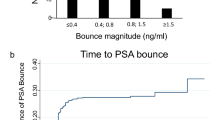Abstract
Background
We aimed to calculate the frequency and features of the development of a prostate-specific antigen (PSA) bounce after prostate brachytherapy alone, to correlate the bounce with clinical and dosimetric factors and to identify factors that predict PSA bounce.
Methods
PSA bounce was evaluated in 86 patients with T1-T2 prostate cancer who underwent radioactive seed implantation using iodine-125 (I-125) without hormonal therapy or external-beam radiation therapy (EBRT) from September 2004 to December 2007. A PSA bounce was defined as a rise of at least 0.4 ng/ml greater than a previous PSA level with a subsequent decline equal to, or less than, the initial nadir.
Results
Calculated by the Kaplan-Meier method, the incidence of PSA bounce at a 2-year follow-up was 26%. Median time to the PSA bounce was 15 months. Univariate analysis demonstrated that age, dose received by 90% of the prostate gland (D90), volume of gland receiving 100% of the prescribed dose (V100), and V150 were significantly associated with the PSA bounce, while pretreatment PSA level, Gleason score, pretreatment prostate volume, clinical T stage, and V200 were not. In multivariate analysis, age 67 years or less and D90 more than 180 Gy were identified as independent factors for predicting the PSA bounce (P < 0.05).
Conclusion
PSA bounce is not a rare phenomenon after prostate brachytherapy. It is more common in younger patients and patients receiving higher doses of radiation.
Similar content being viewed by others
References
Whitmore WF Jr, Hilaris B, Grabstald H (1972) Retropubic implantation to iodine 125 in the treatment of prostatic cancer. J Urol 108:918–920
Patel C, Elshaikh MA, Angermeier K, et al. (2004) PSA bounce predicts early success in patients with permanent iodine-125 prostate implant. Urology 63:110–113
Toledano A, Chauveinc L, Flam T, et al. (2006) PSA bounce after permanent implant prostate brachytherapy may mimic a biochemical failure: a study of 295 patients with a minimum 3-year followup. Brachytherapy 5:122–126
Das P, Chen MH, Valentine K, et al. (2002) Using the magnitude of PSA bounce after MRI-guided prostate brachytherapy to distinguish recurrence, benign precipitating factors, and idiopathic bounce. Int J Radiat Oncol Biol Phys 54:698–702
Stock RG, Stone NN, Cesaretti JA (2003) Prostate-specific antigen bounce after prostate seed implantation for localized prostate cancer: descriptions and implications. Int J Radiat Oncol Biol Phys 56:448–453
Ciezki JP, Reddy CA, Garcia J, et al. (2006) PSA kinetics after prostate brachytherapy: PSA bounce phenomenon and its implications for PSA doubling time. Int J Radiat Oncol Biol Phys 64: 512–517
Crook J, Gillan C, Yeung I, et al. (2007) PSA kinetics and PSA bounce following permanent seed prostate brachytherapy. Int J Radiat Oncol Biol Phys 69:426–433
Critz FA, Williams WH, Benton JB, et al. (2000) Prostate specific antigen bounce after radioactive seed implantation followed by external beam radiation for prostate cancer. J Urol 163:1085–1089
Critz FA, Williams WH, Levinson AK, et al. (2003) Prostate specific antigen bounce after simultaneous irradiation for prostate cancer: the relationship to patient age. J Urol 170:1864–1867
Saito S, Nagata H, Kosugi M, et al. (2007) Brachytherapy with permanent seed implantation. Int J Clin Oncol 12:395–407
Mitchell DM, Swindell R, Elliott T, et al. (2008) Analysis of prostate-specific antigen bounce after I(125) permanent seed implant for localised prostate cancer. Radiother Oncol 88:102–107
Satoh T, Ishiyama H, Matsumoto K, et al. (2008) Prostate-specific antigen “bounce” after permanent (125)I-implant brachytherapy in Japanese men: a multi-institutional pooled analysis. BJU Int 103: 1064–1068
American Society for Therapeutic Radiology and Oncology Consensus Panel (1997) Consensus statement: guidelines for PSA following radiation therapy. Int J Radiat Oncol Biol Phys 37:1035–1041
Roach M 3rd, Hanks G, Thames H Jr, et al. (2006) Defining biochemical failure following radiotherapy with or without hormonal therapy in men with clinically localized prostate cancer: recommendations of the RTOG-ASTRO Phoenix Consensus Conference. Int J Radiat Oncol Biol Phys 65:965–974
Atzpodien J, Royston P, Wandert T, et al. (2003) Metastatic renal carcinoma comprehensive prognostic system. Br J Cancer 88: 348–353
Iannuzzi CM, Stock RG, Stone NN (1999) PSA kinetics following I-125 radioactive seed implantation in the treatment of T1-T2 prostate cancer. Radiat Oncol Investig 7:30–35
Grimm PD, Blasko JC, Sylvester JE, et al. (2001) Ten-year biochemical (prostate-specific antigen) control of prostate cancer with (125)I brachytherapy. Int J Radiat Oncol Biol Phys 51:31–40
Critz FA (2002) Time to achieve a prostate specific antigen nadir of 0.2 ng/ml after simultaneous irradiation for prostate cancer. J Urol 168:2434–2438
Rosser CJ, Kuban DA, Levy LB, et al. (2002) Prostate specific antigen bounce phenomenon after external beam radiation for clinically localized prostate cancer. J Urol 168:2001–2005
Hanlon AL, Pinover WH, Horwitz EM, et al. (2001) Patterns and fate of PSA bouncing following 3D-CRT. Int J Radiat Oncol Biol Phys 50:845–849
Author information
Authors and Affiliations
Corresponding author
About this article
Cite this article
Kanai, K., Nakashima, J., Sugawara, A. et al. Prediction of PSA bounce after permanent prostate brachytherapy for localized prostate cancer. Int J Clin Oncol 14, 502–506 (2009). https://doi.org/10.1007/s10147-009-0909-0
Received:
Accepted:
Published:
Issue Date:
DOI: https://doi.org/10.1007/s10147-009-0909-0




